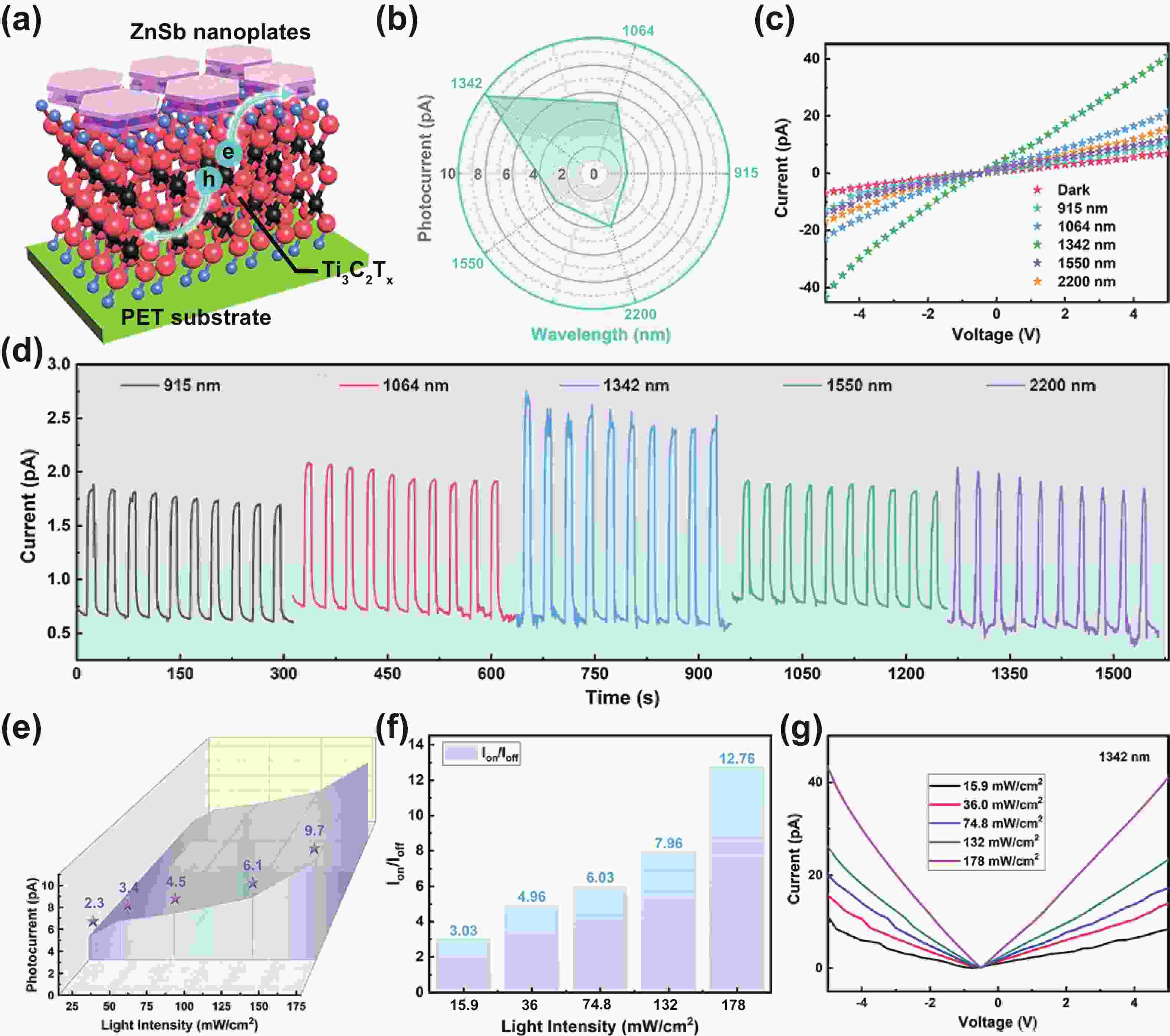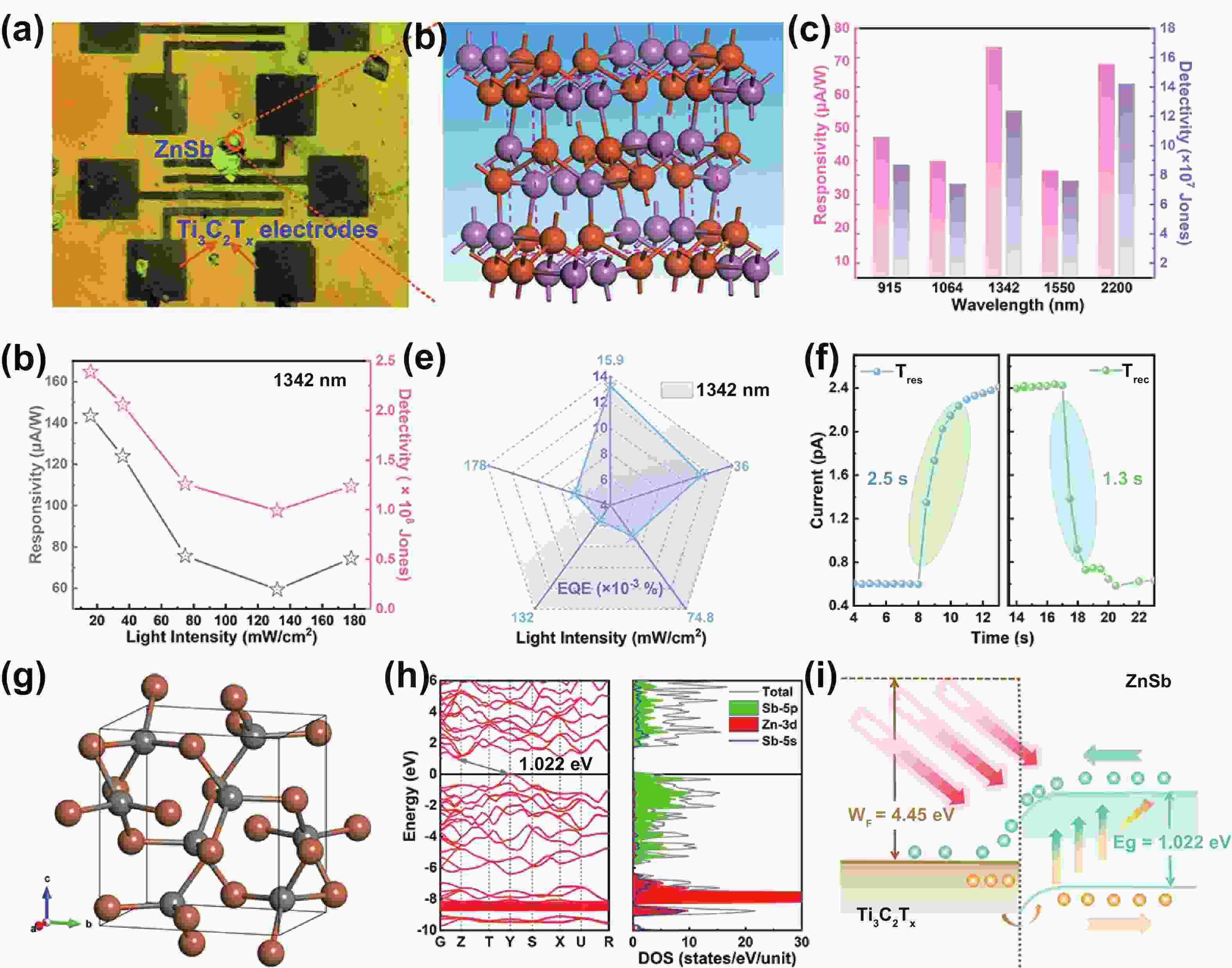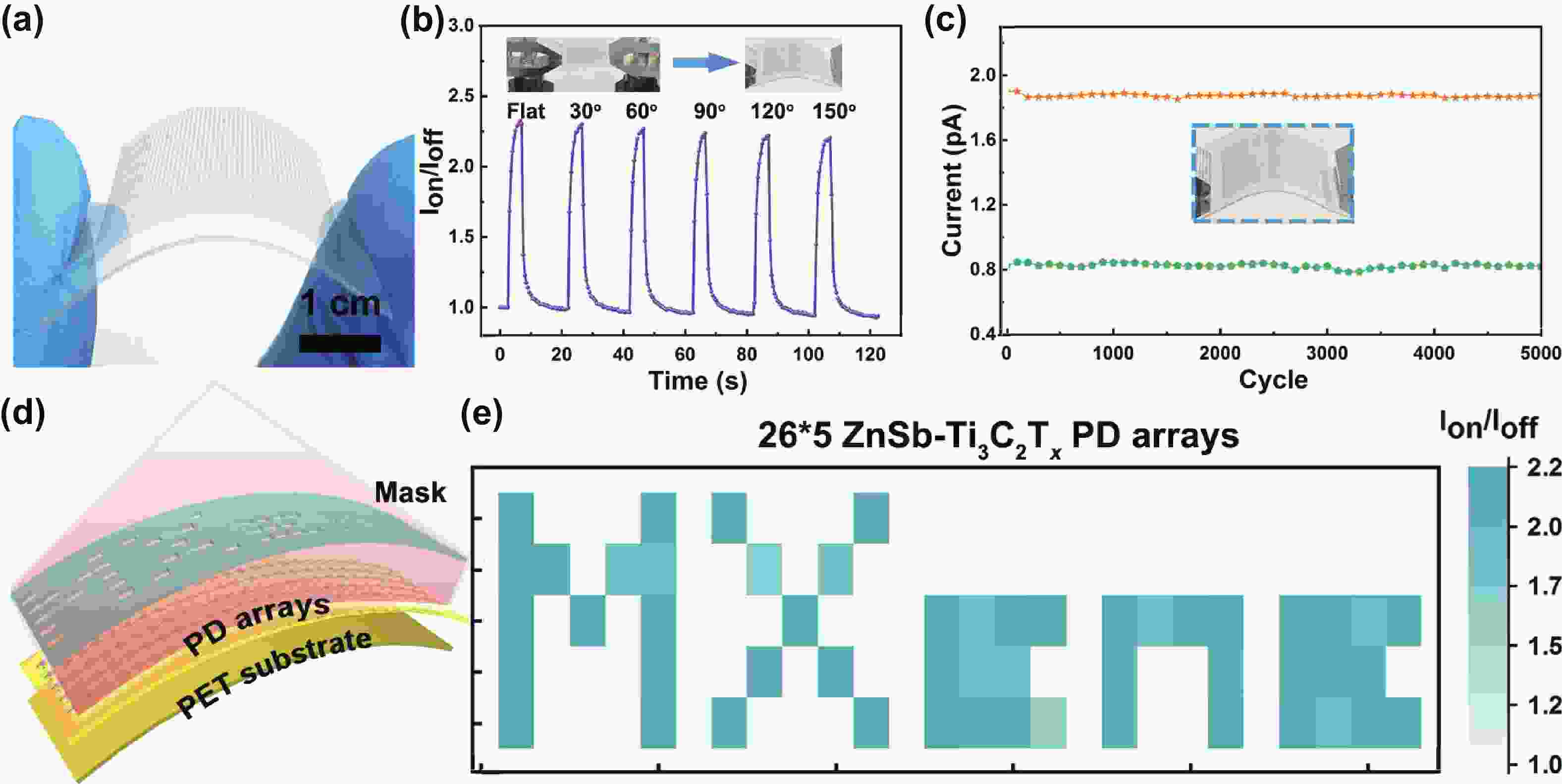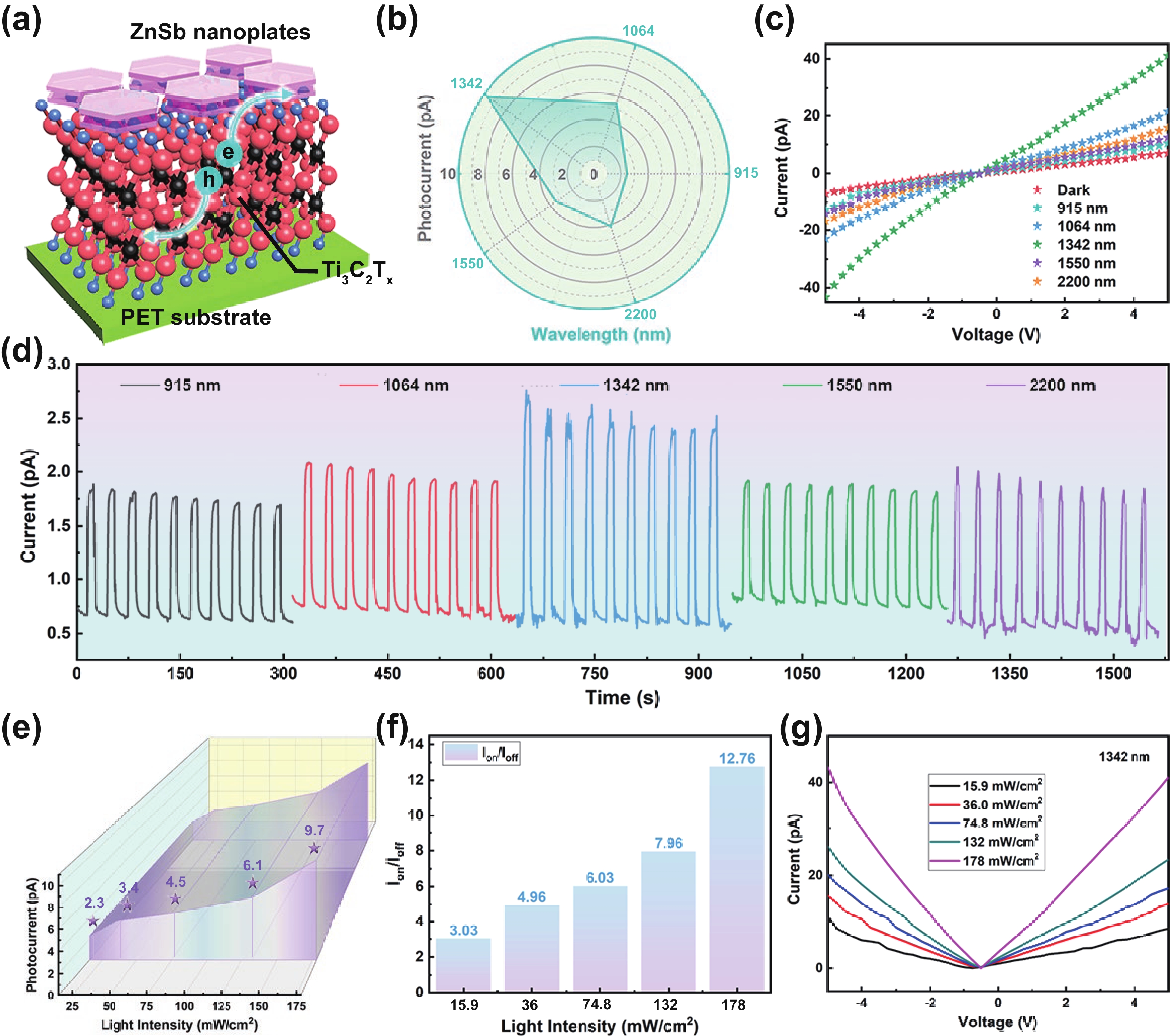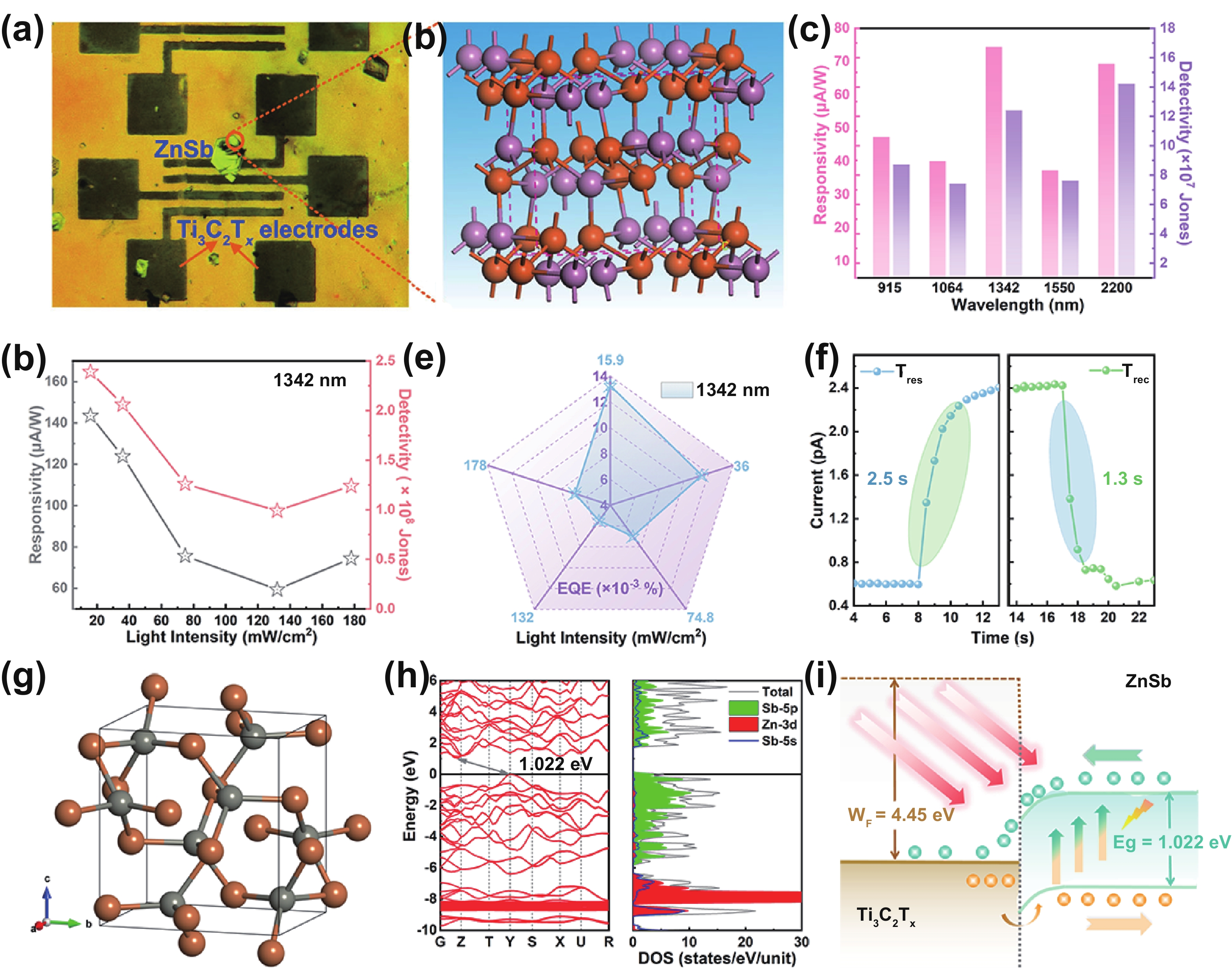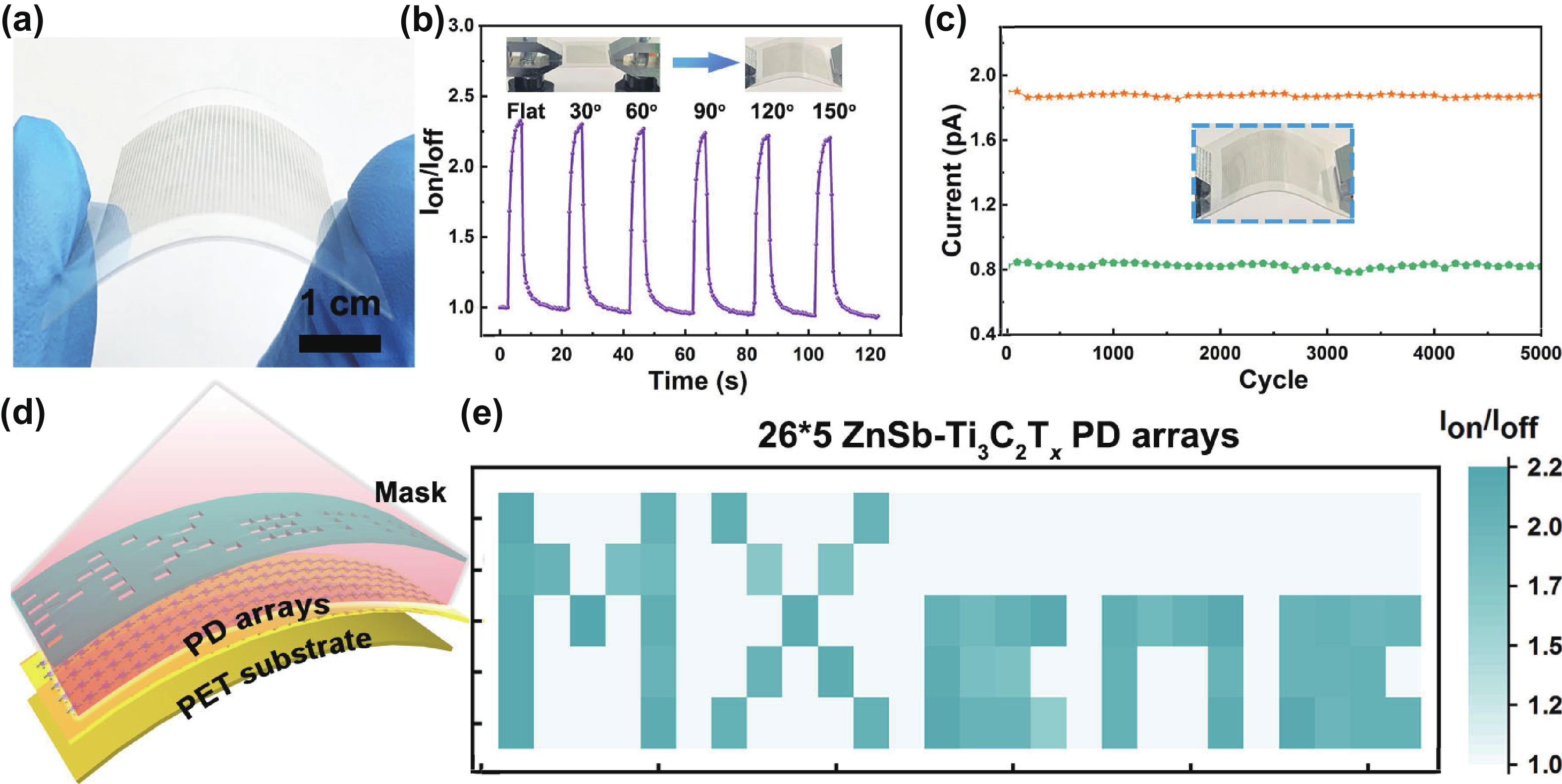| Citation: |
Chuqiao Hu, Ruiqing Chai, Zhongming Wei, La Li, Guozhen Shen. ZnSb/Ti3C2Tx MXene van der Waals heterojunction for flexible near-infrared photodetector arrays[J]. Journal of Semiconductors, 2024, 45(5): 052601. doi: 10.1088/1674-4926/45/5/052601
C Q Hu, R Q Chai, Z M Wei, L Li, and G Z Shen, ZnSb/Ti3C2Tx MXene van der Waals heterojunction for flexible near-infrared photodetector arrays[J]. J. Semicond., 2024, 45(5), 052601 doi: 10.1088/1674-4926/45/5/052601
Export: BibTex EndNote
|
ZnSb/Ti3C2Tx MXene van der Waals heterojunction for flexible near-infrared photodetector arrays
doi: 10.1088/1674-4926/45/5/052601
More Information-
Abstract
Two-dimension (2D) van der Waals heterojunction holds essential promise in achieving high-performance flexible near-infrared (NIR) photodetector. Here, we report the successful fabrication of ZnSb/Ti3C2Tx MXene based flexible NIR photodetector array via a facile photolithography technology. The single ZnSb/Ti3C2Tx photodetector exhibited a high light-to-dark current ratio of 4.98, fast response/recovery time (2.5/1.3 s) and excellent stability due to the tight connection between 2D ZnSb nanoplates and 2D Ti3C2Tx MXene nanoflakes, and the formed 2D van der Waals heterojunction. Thin polyethylene terephthalate (PET) substrate enables the ZnSb/Ti3C2Tx photodetector withstand bending such that stable photoelectrical properties with non-obvious change were maintained over 5000 bending cycles. Moreover, the ZnSb/Ti3C2Tx photodetectors were integrated into a 26 × 5 device array, realizing a NIR image sensing application. -
References
[1] Feng X Q, He Z Y, Liu Z D, et al. Intact vertical 3D–0D–2D carbon-based p–n junctions for use in high-performance photodetectors. Adv Opt Mater, 2021, 9, 2100387 doi: 10.1002/adom.202100387[2] Feng Z Y, Wu Z X, Hua Y K, et al. Controlled growth of perovskite KMnF3 upconverting nanocrystals for near-infrared light-sensitive perovskite solar cells and photodetectors. J Mater Sci, 2021, 56, 14207 doi: 10.1007/s10853-021-06173-w[3] He Z Y, Han J Y, Du X Y, et al. Photomemory and pulse monitoring featured solution-processed near-infrared graphene/organic phototransistor with detectivity of 2.4 × 1013 Jones. Adv Funct Materials, 2021, 31, 2103988 doi: 10.1002/adfm.202103988[4] Eun H J, Kye H, Kim D, et al. Effective dark current suppression for high-detectivity organic near-infrared photodetectors using a non-fullerene acceptor. ACS Appl Mater Interfaces, 2021, 13, 11144 doi: 10.1021/acsami.0c22808[5] Jang H, Seok Y, Choi Y, et al. High-performance near-infrared photodetectors based on surface-doped InSe. Adv Funct Materials, 2021, 31, 2006788 doi: 10.1002/adfm.202006788[6] Liu G Y, Bao X Z, Dong W K, et al. Two-dimensional Bi2Sr2CaCu2O8+ δ nanosheets for ultrafast photonics and optoelectronics. ACS Nano, 2021, 15, 8919 doi: 10.1021/acsnano.1c01567[7] Hu C Q, Wei Z M, Li L, et al. Strategy toward semiconducting Ti3C2T x-MXene: Phenylsulfonic acid groups modified Ti3C2T x as photosensitive material for flexible visual sensory-neuromorphic system. Adv Funct Materials, 2023, 33, 2302188 doi: 10.1002/adfm.202302188[8] Ghorai N, Ghosh H N. Ultrafast plasmon dynamics in near-infrared active non-stoichiometric Cu2– xSe nanocrystals and effect of chemical interface damping. J Phys Chem C, 2021, 125, 11468 doi: 10.1021/acs.jpcc.1c03166[9] Zhong Z M, Peng F, Huang Z Q, et al. High-detectivity non-fullerene organic photodetectors enabled by a cross-linkable electron blocking layer. ACS Appl Mater Interfaces, 2020, 12, 45092 doi: 10.1021/acsami.0c13833[10] Cai W F, Wang J Y, He Y M, et al. Strain-modulated photoelectric responses from a flexible α-In2Se3/3R MoS2 heterojunction. Nanomicro Lett, 2021, 13, 74 doi: 10.1007/s40820-020-00584-1[11] Cao F, Xu X B, Yu D J, et al. Lead-free halide perovskite photodetectors spanning from near-infrared to X-ray range: A review. Nanophotonics-Berlin, 2020, 10, 2221 doi: 10.1515/nanoph-2020-0632[12] Chen J S, Liu D Z, Al-Marri M J, et al. Photo-stability of CsPbBr3 perovskite quantum dots for optoelectronic application. Sci China Mater, 2016, 59, 719 doi: 10.1007/s40843-016-5123-1[13] Sarkar S S, Bera S, Hassan M S, et al. MoSe2–Cu2– xS/GaAs heterostructure-based self-biased two color-band photodetectors with high detectivity. J Phys Chem C, 2021, 125, 10768 doi: 10.1021/acs.jpcc.1c02038[14] Liang D D, Wei T B, Wang J X, et al. Quasi van der Waals epitaxy nitride materials and devices on two dimension materials. Nano Energy, 2020, 69, 104463 doi: 10.1016/j.nanoen.2020.104463[15] Wang H D, Gao S, Zhang F, et al. Repression of interlayer recombination by graphene generates a sensitive nanostructured 2D vdW heterostructure based photodetector. Adv Sci, 2021, 8, e2100503 doi: 10.1002/advs.202100503[16] Gao F, Chen H Y, Feng W, et al. High-performance van der waals metal-insulator-semiconductor photodetector optimized with valence band matching. Adv Funct Materials, 2021, 31, 2104359 doi: 10.1002/adfm.202104359[17] Zheng X Y, Wei Y D, Pang K J, et al. PN/PAs-WSe2 van der waals heterostructures for solar cell and photodetector. Sci Reports, 2020, 10, 17213 doi: 10.1038/s41598-020-73152-7[18] Qin S C, Du Q Q, Dong R X, et al. Robust, flexible and broadband photodetectors based on van der Waals graphene/C60 heterostructures. Carbon, 2020, 167, 668 doi: 10.1016/j.carbon.2020.06.056[19] Hao Q Y, Liu J D, Dong W L, et al. Visible to near-infrared photodetector with novel optoelectronic performance based on graphene/S-doped inse heterostructure on h-bn substrate. Nanoscale, 2020, 12, 19259 doi: 10.1039/D0NR04338A[20] Chen Y, Wang X D, Huang L, et al. Ferroelectric-tuned van der Waals heterojunction with band alignment evolution. Nat Commun, 2021, 12, 4030 doi: 10.1038/s41467-021-24296-1[21] Kim K S, Ji Y J, Kim K H, et al. Ultrasensitive MoS2 photodetector by serial nano-bridge multi-heterojunction. Nat Commun, 2019, 10, 4701 doi: 10.1038/s41467-019-12592-w[22] Novoselov K S, Geim A K, Morozov S V, et al. Electric field effect in atomically thin carbon films. Science, 2004, 306, 666 doi: 10.1126/science.1102896[23] Tian H, Chin M L, Najmaei S, et al. Optoelectronic devices based on two-dimensional transition metal dichalcogenides. Nano Res, 2016, 9, 1543 doi: 10.1007/s12274-016-1034-9[24] Zheng W H, Jiang Y, Hu X L, et al. Light emission properties of 2D transition metal dichalcogenides: Fundamentals and applications. Adv Opt Mater, 2018, 6, 1800420 doi: 10.1002/adom.201800420[25] Xie Y, Zhang B, Wang S X, et al. Ultrabroadband MoS2 photodetector with spectral response from 445 to 2717 nm. Adv Mater, 2017, 29, 1605972 doi: 10.1002/adma.201605972[26] Hu C Q, Li L, Shen G Z. Flexible transparent near-infrared photodetector based on 2D Ti3C2 MXene-Te van der waals heterostructures. Chin J Chem, 2021, 39, 2141 doi: 10.1002/cjoc.202100229[27] Ouyang W X, Chen J X, He J H, et al. Improved photoelectric performance of UV photodetector based on ZnO nanoparticle-decorated BiOCl nanosheet arrays onto PDMS substrate: The heterojunction and Ti3C2Tx MXene conduction layer. Adv Electron Mater, 2020, 6, 2000168 doi: 10.1002/aelm.202000168[28] Xu J, Shim J, Park J H, et al. MXene electrode for the integration of WSe2 and MoS2 field effect transistors. Adv Funct Materials, 2016, 26, 5328 doi: 10.1002/adfm.201600771[29] Yang Y J, Jeon J, Park J H, et al. Plasmonic transition metal carbide electrodes for high-performance InSe photodetectors. ACS Nano, 2019, 13, 8804 doi: 10.1021/acsnano.9b01941[30] Bafekry A, Shahrokhi M, Yagmurcukardes M, et al. Surface functionalization of the honeycomb structure of zinc antimonide (ZnSb) monolayer: A first-Principles study. Surf Sci, 2021, 707, 121796 doi: 10.1016/j.susc.2020.121796[31] Chai R Q, Chen Y F, Zhong M, et al. Non-layered ZnSb nanoplates for room temperature infrared polarized photodetectors. J Mater Chem C, 2020, 8, 6388 doi: 10.1039/D0TC00755B[32] Li L, Fu X Y, Chen S, et al. Hydrophobic and stable MXene-polymer pressure sensors for wearable electronics. ACS Appl Mater Interfaces, 2020, 12, 15362 doi: 10.1021/acsami.0c00255[33] Li L D, Gu L L, Lou Z, et al. ZnO quantum dot decorated Zn2SnO4 nanowire heterojunction photodetectors with drastic performance enhancement and flexible ultraviolet image sensors. ACS Nano, 2017, 11, 4067 doi: 10.1021/acsnano.7b00749[34] Li D P, Yip S, Li F Z, et al. Flexible near-infrared InGaSb nanowire array detectors with ultrafast photoconductive response below 20 µs. Adv Opt Mater, 2020, 8, 2001201 doi: 10.1002/adom.202001201[35] Yu X C, Li Y Y, Hu X N, et al. Narrow bandgap oxide nanoparticles coupled with graphene for high performance mid-infrared photodetection. Nat Commun, 2018, 9, 4299 doi: 10.1038/s41467-018-06776-z[36] Li L D, Lou Z, Shen G Z. Flexible broadband image sensors with SnS quantum dots/Zn2SnO4 nanowires hybrid nanostructures. Adv Funct Materials, 2018, 28, 1705389 doi: 10.1002/adfm.201705389[37] Li L, Liu W J, Jiang K, et al. In-situ annealed Ti3C2T x MXene based all-solid-state flexible Zn-ion hybrid micro supercapacitor array with enhanced stability. Nanomicro Lett, 2021, 13, 100 doi: 10.1007/s40820-021-00634-2[38] Hu C Q, Du Z J, Wei Z M, et al. Functionalized Ti3C2T x MXene with layer-dependent band gap for flexible NIR photodetectors. Appl Phys Rev, 2023, 10, 021402 doi: 10.1063/5.0140861 -
Supplements
 23120004Supporting_Information.pdf
23120004Supporting_Information.pdf

-
Proportional views





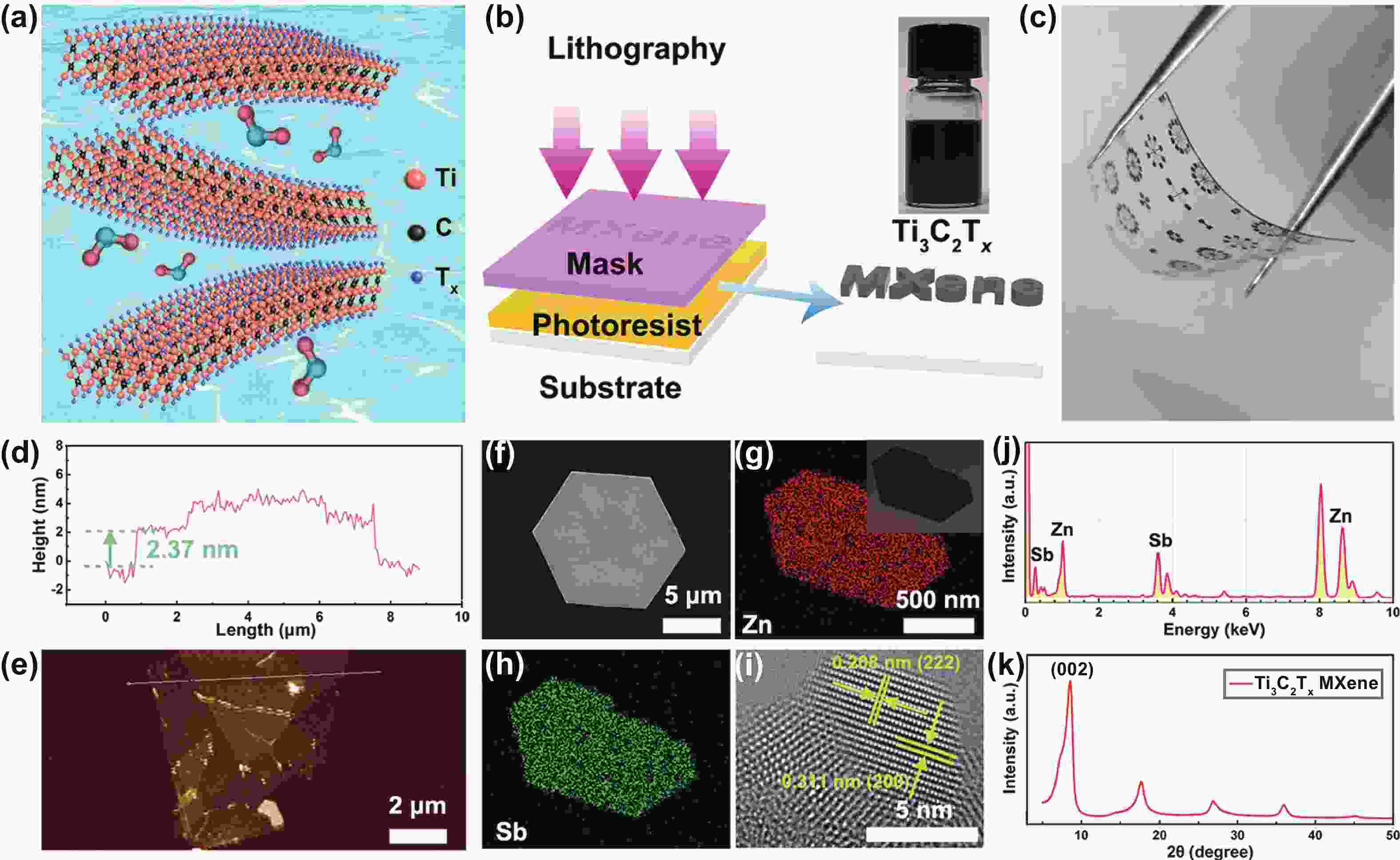
 DownLoad:
DownLoad:
